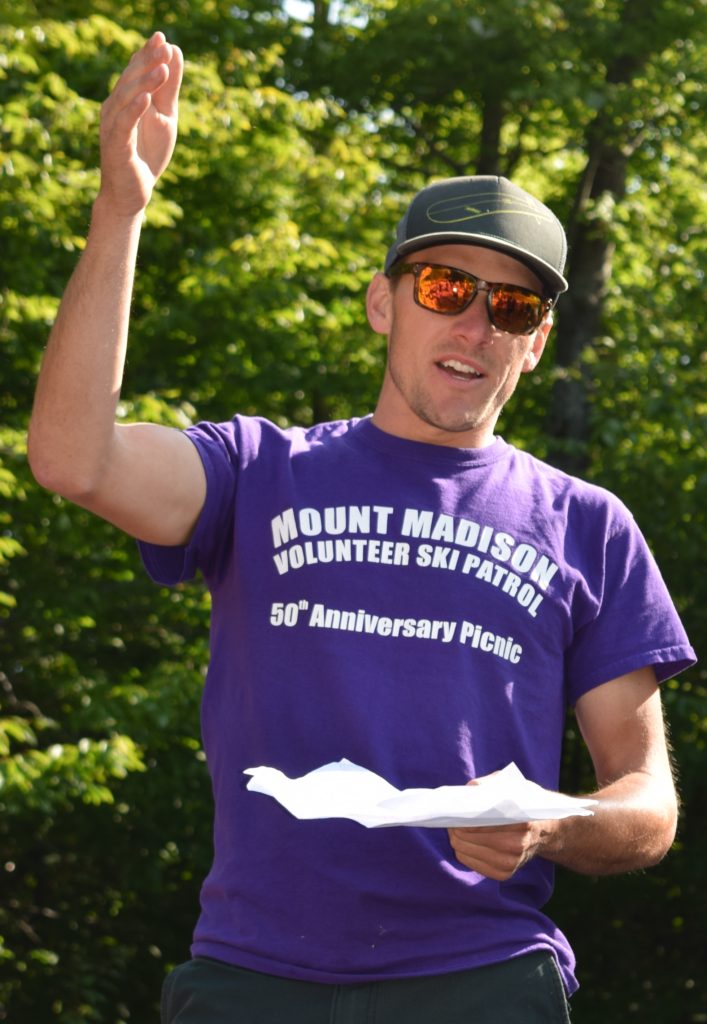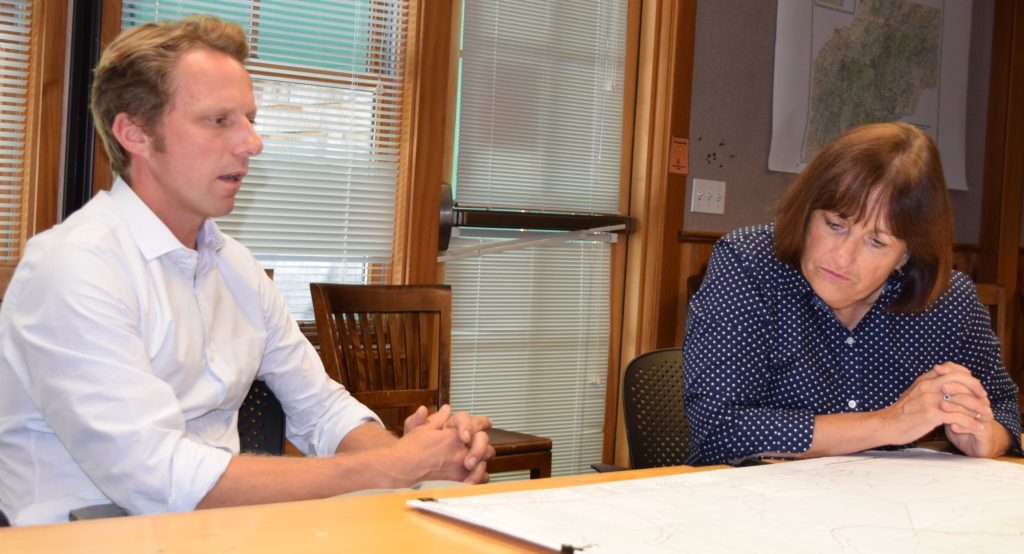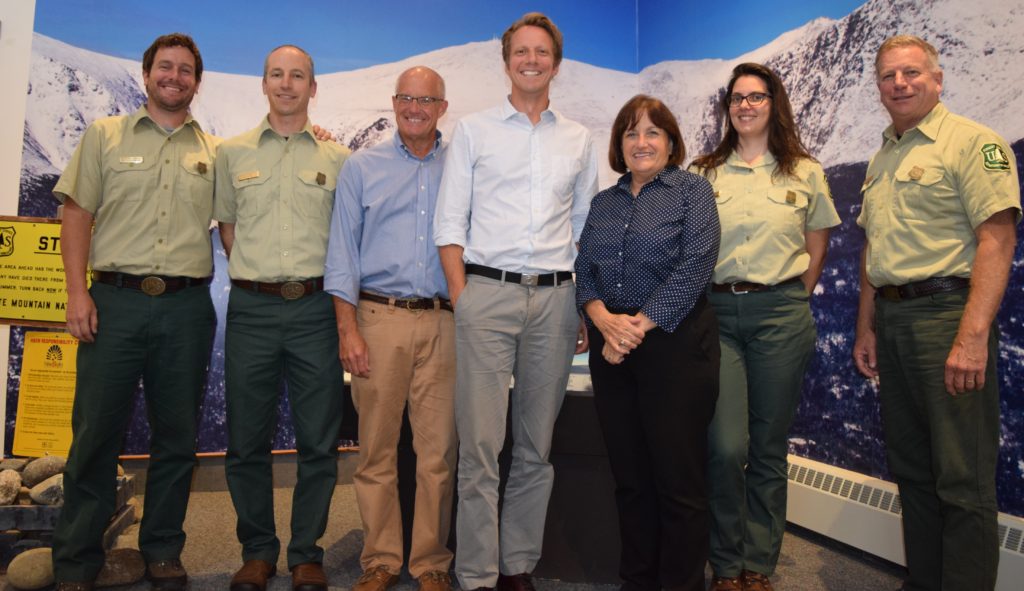This story is reprinted with the permission of The Berlin Sun and Edith Tucker. The Forest Commission thanks them both.
By Edith Tucker The Berlin Sun RANDOLPH — Sixty volunteer members of the Granite Backcountry Alliance (GBA) turned out on Saturday morning, Aug. 26, at the Mt. Crescent Trailhead at the top of Randolph Hill Road and a dozen returned the following day to clearing work. Their collective task was to cut down saplings and some larger trees, trim branches and hanging detritus, and clear the understory and hobblebush in four-plus well-marked skiable glade lines — 35 to 50 foot-wide “ski corridors” — on 75 south-east-facing acres in the 10,000-plus-acre Randolph Community Forest (RCF).
First, at 8 a.m. with an eye toward safety, 10 or 12 hardhat-wearing sawyers with chainsaws headed a mile-and-a-half north up toward the Crescent Ridge Trail so they could do some heavy cutting uphill from an existing wildlife opening before some 50 brush draggers, pole sawyers and lopper-wielding volunteers climbed to the site where backcountry skiing is already enjoyed on the (Dave) Dernbach glades. They were instructed only to cut between hanging bright pink and pink-striped ribbons, whose placement was checked out by the RCF forester David DeGruttola of Landvest. GBA employed a glade designer: Sustainable Trail Networks, a consultant responsible for 17,000 vertical feet of glades in the Green Mountain National Forest.
“We finished the entire RCF project, as approved,” reported Granite Chief Tyler Ray of North Conway in a Monday email. “Everything is now ‘winter-ready!’ The volunteers were incredibly energized once we got into the terrain and it became clear the new zone would be really fun.”

RCF glade-master Jeremiah Hawkins of Randolph gave directions and safety instructions to some 50 second-wave volunteers on Saturday at the Mt. Crescent Trailhead on Randolph Hill. (Edith Tucker photo)
At 9 a.m. on Saturday GBA glade-master Jeremiah Hawkins of Randolph said the wildlife opening, which leads to the skin-track on which backcountry skiers climb the slope, was filled with “belly-button-high brambles.” The crowd had first enjoyed breakfast — hot coffee, bagel and pastries — donated by the White Mountain Café in Gorham and the Water Wheel Restaurant in Jefferson. They signed liability waivers and made their own lunches from peanut butter, strawberry jam, and wraps and apples donated by SAALT and other local businesses.
Everyone was invited that evening to an after-work-party BBQ, raffle and social evening with a band at Jason and Kara Hunter’s Hub North in Gorham. The RCF commissioners, including experienced backcountry skier Doug Mayer, had voted their approval to this upgrade to the Forest’s glade area on May 4 and designated the GBA as its backcountry ski activity leader. The Randolph Mountain Club is its hiking trail activity leader; the Waumbek-Methna Snowmobile Club, its snowmobile activity leader. Dave Salisbury of Randolph also worked on the proposal.
Many participants came to Saturday’s work party from a distance. Mike Roy, who drove from the Freeport, Me. area, said he has enjoyed backcountry skiing for 9 years, but also still skis at areas served by lifts and groomers. Bridget Freudenberger of Colebrook, a member of Granite Bank’s commercial loan team, said she used to ski at The Balsams Wilderness Area but is seeking alternatives. Three days before heading up this impressive volunteer effort, two GBA leaders — Ray, a North Conway lawyer and triathlete, and longtime backcountry skier Rick Jenkinson of Kearsage — met with Congresswoman Annie Kuster at the Androscoggin Ranger District headquarters in Gorham. Ray and Jenkinson enthusiastically described for the Kuster, who is a member of the House Agriculture Committee, and also four U.S. Forest Service employees, including soon-to-retire Forest Supervisor Tom Wagner and Andro District Ranger Jennifer Barnhart their dream of opening up many backcountry ski venues on the White Mountain National Forest (WMNF).
GBA was incorporated as a N. H. 501(c)(3) non-profit organization in Sept. 2016. “It has had tremendous success in capturing the momentum of backcountry skiers in what is now the fastest growing segment of the ski industry,” Ray explained. “Skiers are flocking to the backcountry for various reasons: fitness, return to nature, high resort prices, and improvement of backcountry equipment. GBA’s goal is to advance the sport of backcountry skiing in N. H. and western Maine by providing low-impact human-powered backcountry skiing opportunities to the public through the creation, improvement and maintenance of ski glades.” Kuster, a very proficient skier from a family of skiers that included a father who was an original investor in Wildcat Mountain, reminisced about her own backcountry skiing. She recalled an Outward Bound near-misadventure, including high water and near-impossible river crossings that, in the end, proved manageable.

GBA Granite Chief Tyler Ray showed Congresswoman Annie Kuster a map of one of two pilot projects that appears to be nearing approval on the WMNF on Wednesday, Aug. 23, in the Androscoggin District offices in Gorham. (Edith Tucker photo)
The two GBA spokesmen pointed out that the WMNF’s Presidential Range is home to a wide variety of high-alpine, above-treeline skiing. But there’s no network of below-treeline skiing designed to provide safer options when there are dangerous weather and-or avalanche risk conditions. Additional venues could reduce the high concentration of spring skiers in Tuckerman Ravine. “Skiers that cut ski glades on their own terms on either private or public property without permission only hurt the cause,” Ray noted. “Our two-fold strategic model would create exceptional ski terrain in the White Mountains,” he said. “Elevation, aspect and location are very important, especially considering climate change. With smart planning, we can be where the snow is going to stay fresh and protected, providing the best conditions.
The second part complements the first,” Ray continued. “We call it GIMBY — “Glade in my Back Yard”. Each community, particularly those on the fringes of the Whites, should have their own glade to ski, helping to build community. We’ve going from town to town to provide assistance to help grow a network of glades.” The WMNF approved two federal pilot projects that GBA proposed, one on Bartlett Mountain in Bartlett, and the other on South Baldface in Evans Notch in Chatham. The Maple Villa Ski Trail on Bartlett Mountain would revive an abandoned Civilian Conservation Corps (CCC) ski trail, built in the 1930s, and add glades around it. GBA also has projects in Gorham (Pine Hill on land owned by the Gorham Land Company), Lancaster (Mount Prospect in Weeks State Park), Franconia (Cooley Jericho Community Forest). There are a number of issues that must be considered on the WMNF, Supervisor Wagner explained.

Congresswoman Annie Kuster, 5th from left, posed with USFS employees Ed Wright and Brian Johnston; Granite Backcountry Alliance enthusiasts Rick Jenkinson of Kearsage and Tyler Ray of North Conway, plus Androscoggin District Ranger Jennifer Barnhart and WMNF Forest Supervisor Tom Wagner in the Androscoggin District offices in Gorham. (Edith Tucker photo)
GBA was formed after the WMNF’s current master plan was approved. Backcountry skiing, like access for ATVs and other OHRVs, will almost certainly be part of the discussion when the next Forest Plan is developed in 5 years, he said. Participant safety, parking and sanitation, as well as resource issues, such as preserving Bicknell’s thrush habitat, will have taken into account. Wagner said, “Our approach to all user groups must be consistent. However, we do recognize that recreation and tourism predate the creation of this national forest.”
